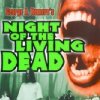If you’ve ever wondered what the most influential horror films of the past 50 years are, ponder no more!
As we are in 2014 right now, I thought I would go back 50 years, no earlier, to bring you what I think is the definitive list of the best horror movies ever made. Now, I don’t claim to have got it right (if there is even such a thing), so let me qualify that. Here are the movies I think have influenced filmmakers more than any other? Don;t agree? Let me know! I’m always looking to expand the list!
And you find this list interesting or helpful, let me know that too! It’s always nice to think you are more than one hand clapping.
PART 1
THE SIXTIES… GOTHIC GORE TO GUT-MUNCHING GHOULS!
As this list promises to be a big one, let’s tackle it decade by decade. Starting with the decade that saw the most change of all, the Supernatural Sixties! We see the swing from Gothic horror to modern survival horror taking place here. But along the way are some great horror movies that are not to be missed!
Masque of the Red Death (1964)
We begin the journey of horror over the past 50 years with a classic Gothic horror tale. It seems appropriate to note just how much storytelling in horror movies was to change over the decade, going from an old-fashioned ghost story to something far more sophisticated and modern, as the audience’s demand to be shocked grew. The Late Fifties were notable for the emergence of British horror studio Hammer as an international force. Their ability to churn out cheap productions of classic horror stories, with added blood and nudity, was a crowd pleaser. Most of the time they used only an old British stately home and some horses. But the Americans soon started making adaptations of their own master of the macabre. And, of course, these were bigger if not better. Roger Corman’s Edge Allen Poe adaptation is one of the best, full of sex, death and menace with a truly great ending that rises above the rather exploitational subject-matter of a wicked price having his way with just about everyone he gets his hands on.
Hush Hush… Sweet Charlotte 1964
A hysterical Southern Gothic tale that boasts some terrific actors (Better Davis, Jospeh Cotton), but which owes much to Tennessee Williams. Almost not a horror movie at all but a sensationalistic thriller. But the atmosphere of dread and tension that hangs over Davis as the tormented and possibly insane Southern belle pushes this into the realm of horror.
Kwaidan 1964
The most expensive film ever made by Japan. This portmanteau film retells several medieval Japanese ghost stories. Among them, “Snow Woman” is the best. Sometimes criticized for being too slow. But each shot is like watching a beautiful Japanese painting. Japanese horror has always been obsessed by the past. At this point, they were still drawing on tales of peasant life for inspiration.
Onibaba 1964
Which brings us to Onibaba (translation: The Hole). This is a must-see World Cinema classic and that rare thing: a horror film that is appreciated by movie critics. Dripping with atmosphere. Two women lure wandering samurai to their deaths using a deep hole in a cornfield. The ending is full of great grotesque irony.
Repulsion 1965
Surreal, bizarre, claustrophobic thriller from Roman Polanski that veers into horror by the sheer intensity of its imagery. Beautiful, young Catherine Deneuve is left alone too much in her apartment, until she starts to go crazy. An exercise in understated menace.
Dracula Prince of Darkness 1965
Sequel to the original Hammer classic. This one sees Christopher Lee not even speaking as the evil Count. It has all the hallmarks of classic Hammer horror: buxom vampire brides, blood so crimson it almost glows, hysterical music. An example of how Gothic horror allowed audiences in the Sixties to experience images that would have been unthinkable in the ‘Fifties.
Dance of the Vampires aka The Fearless Vampire Killers (1967)
Roman Polanski’s comedy horror film is so beautifully shot you could be mistaken for thinking it’s the greater Hammer film ever made. In fact, it’s a quite funny slapstick affair concerning two inept vampire hunters. It also has its genuinely creepy moments.
Kuroneko 1968
Another “feudal” Japanese horror movie. Modern horror hit “The Grudge” owes a debt to this retelling of a classic ghost story involving two women who are killed by pesky bandits and return as cat demons. Some great cinematography makes this a classic of Oriental cinema.
The Devil Rides Out 1968
Another Hammer classic, this time featuring Christopher Lee as the good guy. Devil-worshipping in the English countryside this time, based on the old-schol adventure yarn by Dennis Wheatley. Features a terrific “devil”, although the story is a bit staid compared to a lot of other Hammer productions.
Rosemary’s Baby (1968)
Capitalizing on the Satanism craze of the Swinging Sixties, Ira Levin’s updating of the devil worshipping story to modern-day Manhattan was a huge hit that prefigured the coming of Stephen King a decade or so later. For the first time, the supernatural is found not in an old castle in Transylvania, but in an upscale apartment building. Features the great John Cassavetes and a startling ending that has may have become the paranoid nightmare of pregnant women everywhere. It’s no coincidence that this very realistic supernatural horror came out at the same tie as our next movie…
Night of the Living Dead 1968
And so the Sixties ends with the movie that redefined the horror genre. Many articles have been written on how this is a socio-political tale. The filmmakers have since denied this. According to director George A Romero, the lead actor was originally intended to be a white guy, but at the last minute, he wasn’t available, so they substituted a black actor instead. What a difference! This movie turns many horror clichés on their head. The hero is not the white, lantern-jawed, all-American hero, but a black man (who is probably the only sane guy in the picture). There is no real explanation for the zombies; the dead simply rise from their graves. And they don’t carry the heroine off into the sunset. They eat you. In fact, they eat your guts. Science, often the salvation of the A-Bomb-inspired B-movies of the Fifties, can’t save us either. In fact, nothing can save us. The divided society falls, just as the folks who try to protect themselves in an isolated farmhouse are killed one by one. Romero has since said that Richard Matheson’s novel “I Am Legend” (filmed as both The Omega Man and I Am Legend) inspired the movie. But the real inspiration is the end of the Sixties themselves. The Vietnam War, the Civil Rights movement, and the end of the Hippie dream of free love and peace, had all conspired to create an atmosphere of cynicism. The world is not what it was promised to be. Society is fractured. Tension are rife. The survivors cannot agree on anything. In the end, only ignorance survives – symbolized by the gun-happy rednecks who shoot both the living and the dead at the end of the picture. Still powerfully unsettling today, right down to the last frame, Night of the Living Dead would break new taboos, and pave the way for the more extreme horror of the 70s, and even the “video nasty” era of the 80s…
Next time…
THE SEVENTIES… SLASHERS, SATANISTS, AND A VERY BIG SHARK!



